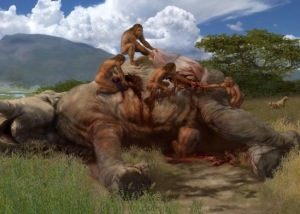
In a very real way, it may have been the lion and the long-extinct sabertoothed cat, not the dog, that was ‘man’s best friend’, if we go back far enough into human prehistory.
In a recently published study in the Journal of Human Evolution, author and paleoanthropologist Briana Pobiner of the Smithsonian Institution’s Human Origins Program shows that it was entirely feasible for early humans living on the African savanna as much as two million or more years ago to acquire enough calories simply by lying in wait and scavenging the remains of prey left by lions or big sabertoothed cats after they finished eating the first cuts.
She concluded this after spending several months in Kenya’s Ol Pejeta Conservancy nature preserve observing, examining, and analyzing large carnivore kills scattered across its grasslands. According to Pobiner, even though it is a modern landscape and environment, it isn’t much different than some of the landscapes that early human ancestors inhabited millions of years ago.
“The site is a great analogue for the kinds of African savanna environments where hominins are thought to have lived,” said Pobiner. “The habitats—both types and varieties—were probably similar, and in this particular place, lions were the dominant predator. This may have been very much like past carnivore communities during the time our ancestors were starting to eat meat from larger animals, when we have evidence that felids—ancient lions, leopards, and three species of sabertoothed cats—lived alongside our ancestors and may have been the dominant kinds of carnivores at this time.“ She points to ancient sites such as Koobi Fora and Olduvai Gorge in East Africa that have yielded evidence of the earliest stone tools, with ancient environments very similar to that of present-day Ol Pejeta where big felids coexisted with humans.
A typical day in the field for Pobiner would begin with listening to a short wave radio for any mention from the conservancy about spotting lions or hearing them roar during the night—particularly if they were eating prey. On a lucky day, she would drive her Land Cruiser along with an armed guard out to the lion site and then simply stop to observe them at a safe distance while they ate. The armed guard was critical. “I didn’t want to become prey myself—to be charged by an elephant, rhino, buffalo, or other angry ungulate,” she said. About one hour after the lions were done and had left the scene, she and her assisting guard would finally approach the kill, meticulously document the remains with photographs and notes, and then pick up the carcass and place it into the back of the Land Cruiser. Later, another assistant would carefully remove the meat from the bones with wooden tools so as not to make any marks that might be confused with tooth marks, and then boil the bones clean. Once the bones were dry, they would be ready for further study.
Apart from potentially angry ungulates, the work was not without other challenges.
“It turns out lions don’t kill things all that often,” Pobiner says. “So getting a large enough sample size was challenging. Another challenge was sometimes having difficulty getting around to get to the carcasses even with my sturdy vehicle during the rainy season when it got really muddy or if I inadvertently drove into a warthog burrow.”
_______________________________________
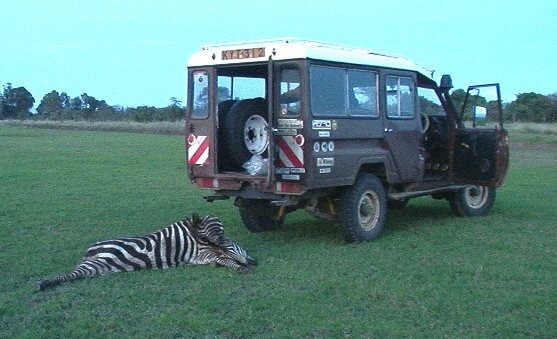 Parked near a kill site. Photo courtesy Briana Pobiner
Parked near a kill site. Photo courtesy Briana Pobiner
______________________________________
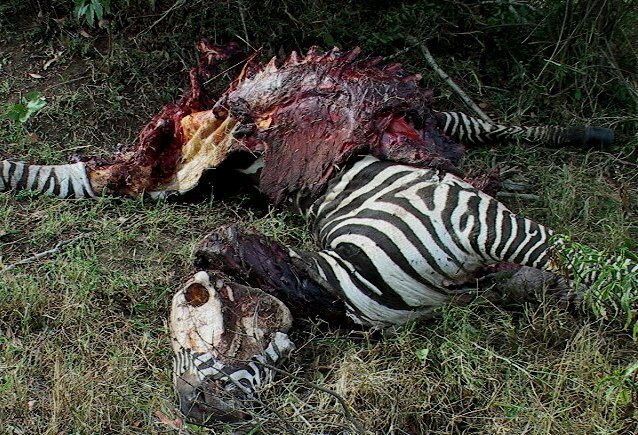 A typical kill site. Photo courtesy Briana Pobiner
A typical kill site. Photo courtesy Briana Pobiner
_________________________________________
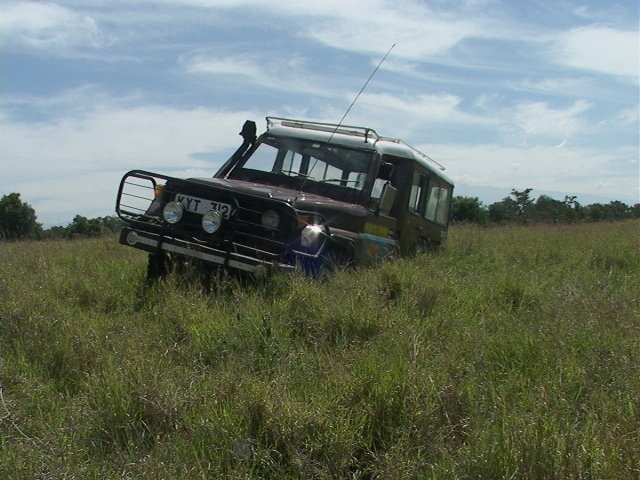 Stuck! One of the many pitfalls of the work. Photo courtesy Briana Pobiner
Stuck! One of the many pitfalls of the work. Photo courtesy Briana Pobiner
_______________________________________________________
For her efforts, however, Pobiner’s work has its rewards. Like others before her, this study could hold answers to questions related to the ongoing debate about early human behavior before the advent of more modern hunting tools and techniques. The debate has revolved around the ‘man the hunter’ hypothesis, which suggests that early humans who lived as much as two million or more years ago procured their meat needs primarily through hunting, versus the ‘man the scavenger’ hypothesis, which proposes that the early humans procured these needs mostly by scavenging the remains left by other preying carnivores, such as lions, sabertoothed cats, hyenas, and other animals. Subsumed within the ‘man the scavenger’ hypothesis has been the question of whether these early humans scavenged primarily as aggressive, confrontational, “power” scavengers who competed with the other carnivores for first access to the prey (such as scaring or beating off a lion from its hunted and killed prey), or as ‘passive’ scavengers who waited until other carnivores got their first prime cuts and then safely went in to pick the carcass for the scraps after the other big carnivores had left the scene. Specifically, Pobiner’s study results indicated that, even after the other large carnivores had their complete fill of the prey and left the carcass to the elements, there would have been enough meat in the scraps to provide a decent meal for a scavenging hominin afterwards. In other words, early humans could have made a living as passive scavengers.
“The most surprising finding was simply the large quantity of meat that lions leave when they eat their kills, which was more than anyone had observed before,” stated Pobiner. “In fact, the leftover meat from just one zebra kill made by lions could have provided almost 6,100 calories for our early human ancestors—that’s the entire daily caloric requirements of almost three adult male Homo erectus individuals, or just over 11 Big Macs. Not bad for a “lowly” scavenger!”
“Part of the criticism of the idea of a scavenging niche is whether there would even be enough meat on a lion kill worth scavenging, especially “passively” scavenging—waiting for the lions to be completely finished rather than chasing them off their kill in “active” or “confrontational” scavenging. My research answers a resounding “yes” to that question.”
_______________________________________
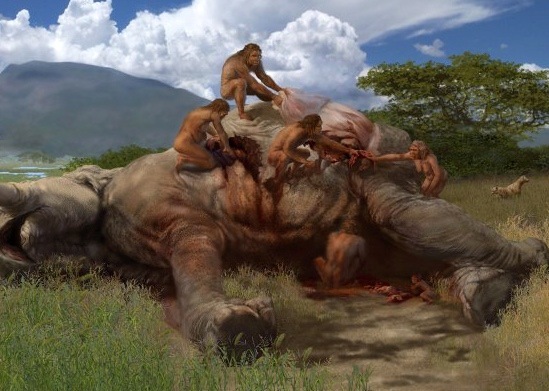 Artist’s depiction of a group of Homo erectus individuals butchering an elephant carcass, based on evidence found of butchered elephant bones, and thousands of stone tools found at Olorgesailie, Kenya, a site where the Smithsonian’s Human Origins Program has conducted excavations. Image courtesy Smithsonian Human Origins Program/Karen Carr
Artist’s depiction of a group of Homo erectus individuals butchering an elephant carcass, based on evidence found of butchered elephant bones, and thousands of stone tools found at Olorgesailie, Kenya, a site where the Smithsonian’s Human Origins Program has conducted excavations. Image courtesy Smithsonian Human Origins Program/Karen Carr
______________________________________
Pobiner has clocked countless hours researching how and when eating meat, a key source of calories, protein and other nutrients, became an important factor in the ultimate evolutionary success of humans.
“Diet is such a crucial part of an organism’s adaptation, and understanding when and how hominins started incorporating meat from large animals into their diets can give us insight into other key adaptations that characterize our lineage – brain size increase, body size increase, home range and group size increase, moving into novel habitats and environments, interactions with other predators, and sophisticated communication and planning, for instance,” she said. “We went from being mostly prey to being the most dominant predator on earth, or at least one of them, in a mere 2.5 million years.”
The detailed study report is published in the Journal of Human Evolution.
__________________________________________________
If you liked this, see also The Bones of Ol Pejeta, by Briana Pobiner and Kris Kovarovic, and Rewriting Human Evolution, a premium article in the September, 2014 issue of Popular Archaeology.
__________________________________________________
Read about the most fascinating discoveries with a premium subscription to Popular Archaeology Magazine. Find out what Popular Archaeology Magazine is all about. AND MORE:
On the go? Get the smartphone version of Popular Archaeology as an app or as an ebook.
Just released!
The special new premium quality print edition of Popular Archaeology Magazine. A beautiful volume for the coffee table.
Travel and learn with Far Horizons.
____________________________________________
Popular Archaeology’s annual Discovery Edition eBook is a selection of the best stories published in Popular Archaeology Magazine in past issues, with an emphasis on some of the most significant, groundbreaking, or fascinating discoveries in the fields of archaeology and paleoanthropology and related fields. At least some of the articles have been updated or revised specifically for the Discovery edition. We can confidently say that there is no other single issue of an archaeology-related magazine, paper print or online, that contains as much major feature article content as this one. The latest issue, volume 2, has just been released. Go to the Discovery edition page for more information.








